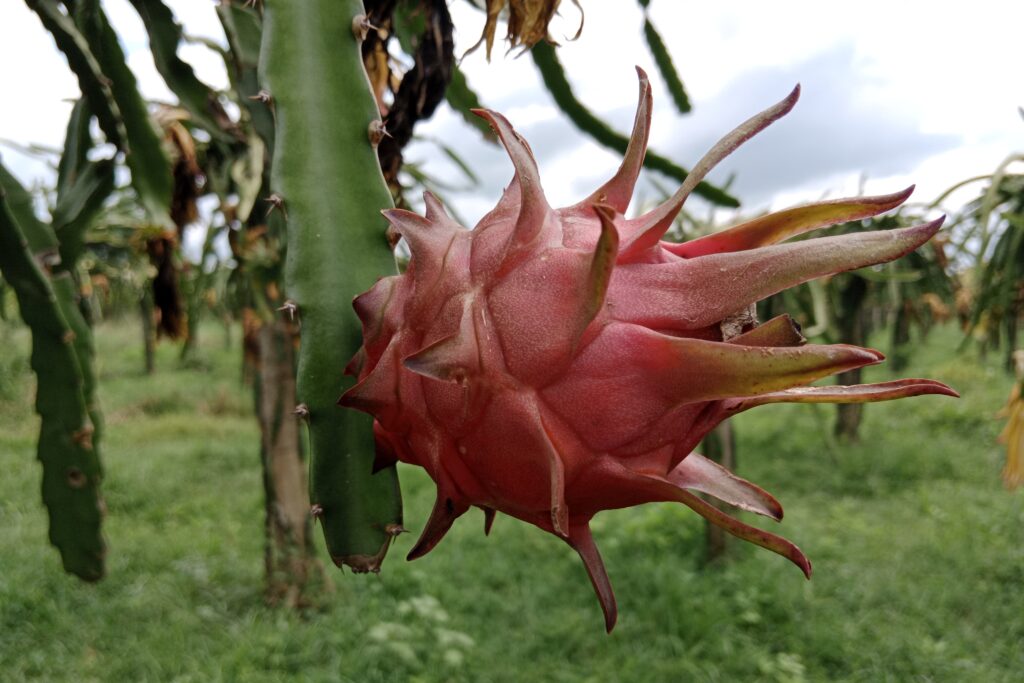Karonda Farming
The South Asian shrub Karonda (Carissa carandas) is robust and drought-tolerant. It is well-known for its tart berries, which are used in traditional medicine, pickles, and jams. Particularly suited to dry and semi-arid areas, it flourishes in poor soils with little maintenance.
Nutritionally speaking, karonda has more vitamin C than oranges, which strengthens immunity and improves the absorption of iron. Additionally, it offers vital nutrients like dietary fiber, calcium, iron, and antioxidants that lower inflammation. It’s perfect for preserving food because of its inherent acidity.
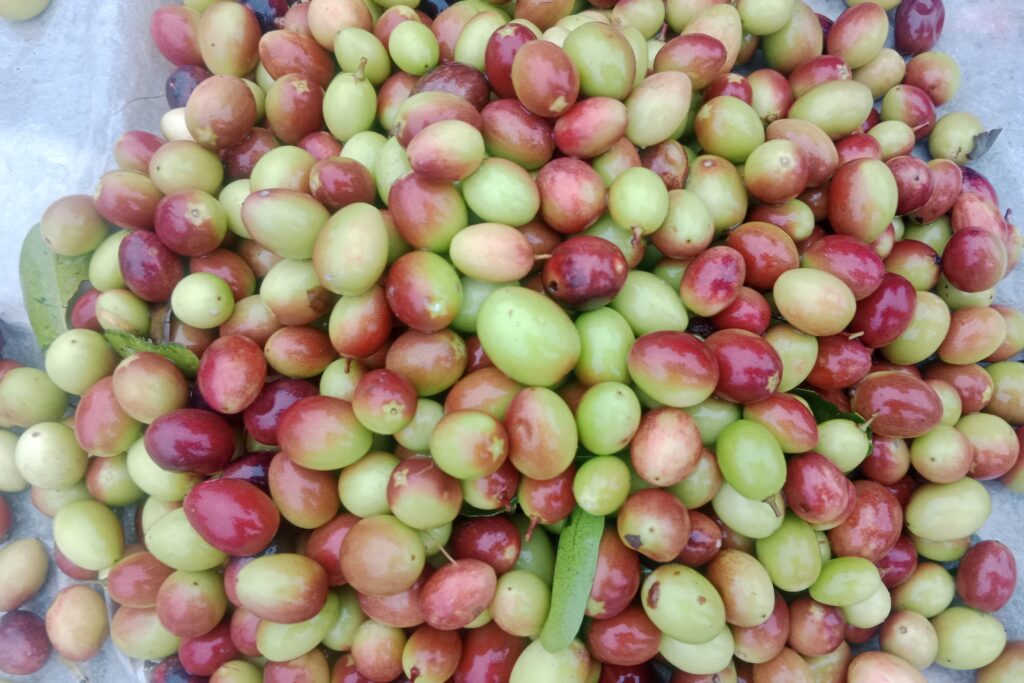
In Ayurveda, karonda has long been used to treat infections, anemia, and arthritis. Its low glycemic index helps manage diabetes, and its antibacterial qualities encourage its usage in functional foods and nutraceuticals, making it a sustainable crop with a variety of different health advantages.
Karonda farming profit per acre presents a promising long-term investment opportunity. Over a 20-year period, the total cost of cultivation amounts to NRs. 1,702,000, which includes an initial investment of NRs. 277,000 and annual maintenance costs of about NRs. 75,000 from the second year onward.
Between Years 3 and 20, the total income generated reaches NRs. 5,370,250—comprising NRs. 970,500 in the early growth phase (Years 3–7), NRs. 3,105,600 during the peak productive years (Years 8–15), and NRs. 1,294,150 in the later years (Years 16–20). This results in a net profit of NRs. 3,668,250, with the break-even point achieved by Year 7.
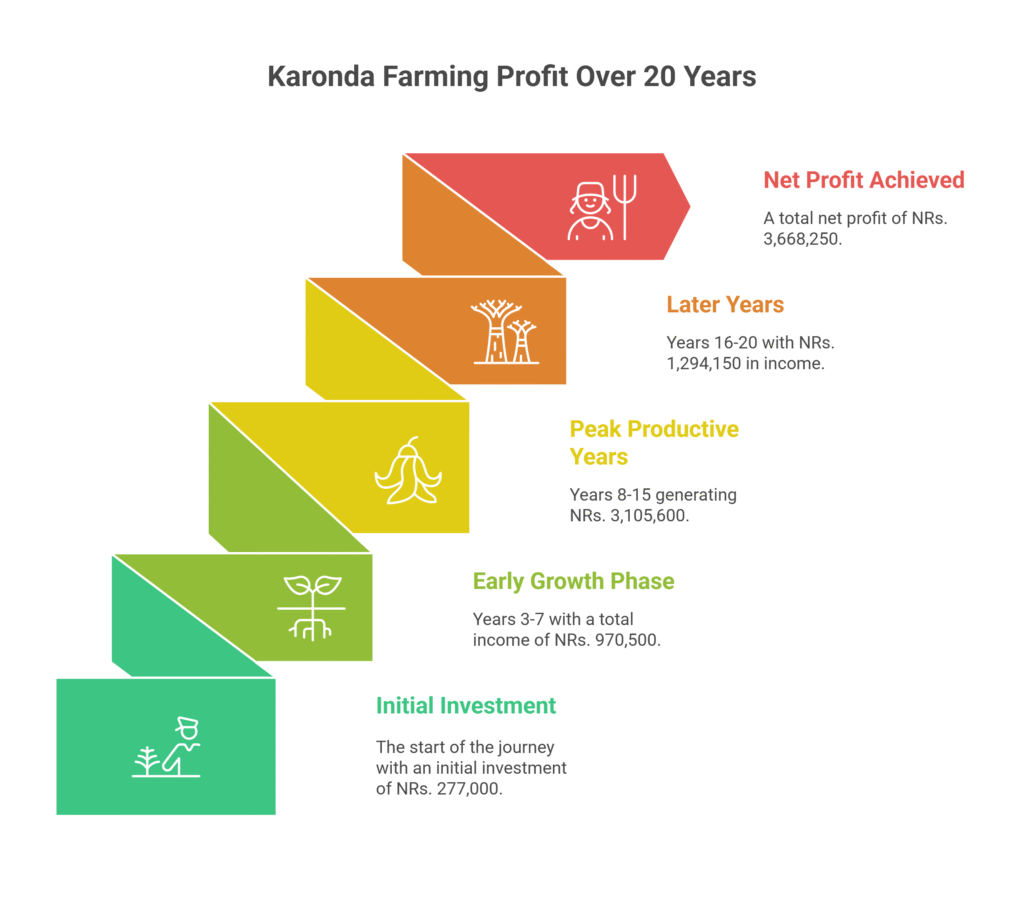
The peak profit phase offers stable annual earnings of approximately NRs. 313,200, while profitability is maintained in later years due to higher market prices despite reduced yields.
Land Preparation
Land preparation for Koronda cultivation involves several key steps to create optimal growing conditions. The process starts with clearing the field by removing weeds, bushes, tree stumps, and rocks, followed by deep plowing to a depth of 20–30 cm using a moldboard plow or tractor-drawn implements to break up compacted soil layers, improve aeration, and enhance root penetration.
This is followed by 2–3 rounds of harrowing to break down large soil clods into a fine tilth and level the field. The plowed soil is then exposed to sunlight for 1–2 weeks to help destroy weed seeds, soil pests, and pathogens. Based on the chosen spacing, basins or pits are marked for transplanting seedlings.
Proper drainage is also essential, with adequate land slope or drainage channels provided—particularly in heavy soils or high rainfall areas—since Koronda plants are highly sensitive to waterlogging.
Soil Type
Karonda grows well in marginal grounds where many other crops find it difficult to grow because it can tolerate a wide range of soil types, including poor, rocky, gravelly, and saline soils. It thrives in sandy loam to loam soils that are deep, well-drained, and have a pH between 6.5 and 8.0. It can withstand both alkalinity and salinity. Because prolonged waterlogging can cause root rot and plant mortality, it is imperative to ensure adequate drainage.
Climatic Requirements
Karonda grows best in tropical and subtropical climates, with optimal temperatures ranging from 20°C to 38°C. While mature plants can endure extreme summer heat above 45°C, young plants require protection from intense heat. The crop is highly sensitive to frost, which can kill young shoots and damage mature plants, making it unsuitable for regions with frequent winter frosts.
It performs well in areas receiving moderate annual rainfall of 600–1000 mm and, once established, shows excellent drought tolerance, making it ideal for arid and semi-arid zones. For best growth, flowering, and fruiting, Karonda requires full sunlight and does not tolerate heavy shade.
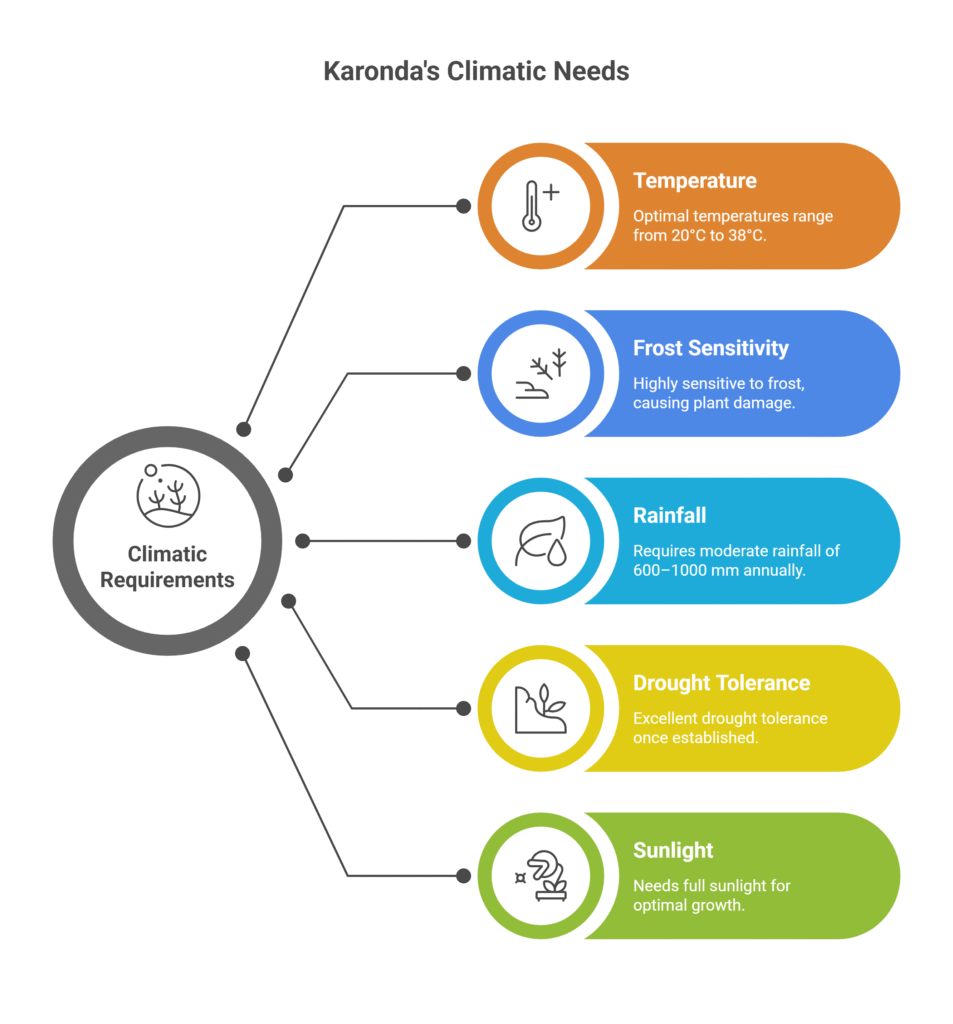
Major Cultivars
Unlike major fruit crops, Karonda has relatively few formally named and improved cultivars, with most selections derived from regional landraces or wild types exhibiting desirable traits. Key factors considered in selection include larger fruit size, thicker flesh with more pulp relative to seed, reduced or nearly absent spines, high and consistent yields, and variations in acidity or taste, with some types specifically chosen for lower acidity.
Notable Karonda cultivars include Pant Manohar, valued for its larger fruit size and high yield, and Konkan Bold, developed from the Konkan region of Maharashtra. Numerous local landraces are also grown across India, such as ‘Green,’ ‘Purple,’ and ‘Dwarf,’ which vary in fruit color, size, and thorniness, with ‘Purple’ types being popular for processing. Other recognized selections include Pant Sudarshan, Pant Suvarna, CHES-K-II-7, and CHES-K-V-6.
Propagation
Karonda can be propagated through seeds, stem cuttings, and air-layering, each offering specific benefits. Seed propagation is an easy and economical method, though it may lead to variations in plant traits and requires more time for fruiting.
Vegetative methods such as stem cuttings and air-layering are preferred for producing true-to-type plants and achieving earlier fruit production. Semi-hardwood cuttings treated with rooting hormones like Indole-3-butyric acid (IBA)—the most widely used root-promoting chemical in nurseries—along with 1-naphthaleneacetic acid (NAA), show higher rooting success.
Air-layering performed during the rainy season also ensures high survival rates. In all methods, selecting healthy, disease-free mother plants is essential for vigorous growth and superior yields.
Seed Rate per Acre
| From Seed | |
| Seedlings per Acre | Requires ~650 plants |
| Seed Requirement | ~500-800 grams per acre |
| Accounts for 60-70% germination rate + seedling mortality during raising | |
| Vegetative Propagation | |
| Cuttings/ Air -Layering | Requires ~650 units |
Planting
Planting Season
The best time to plant Karonda is at the onset of the monsoon season (June–July), as this period provides sufficient soil moisture for successful establishment. In areas with reliable irrigation, planting can also be done in spring (February–March) to avoid the extreme heat of summer during the early growth stages.
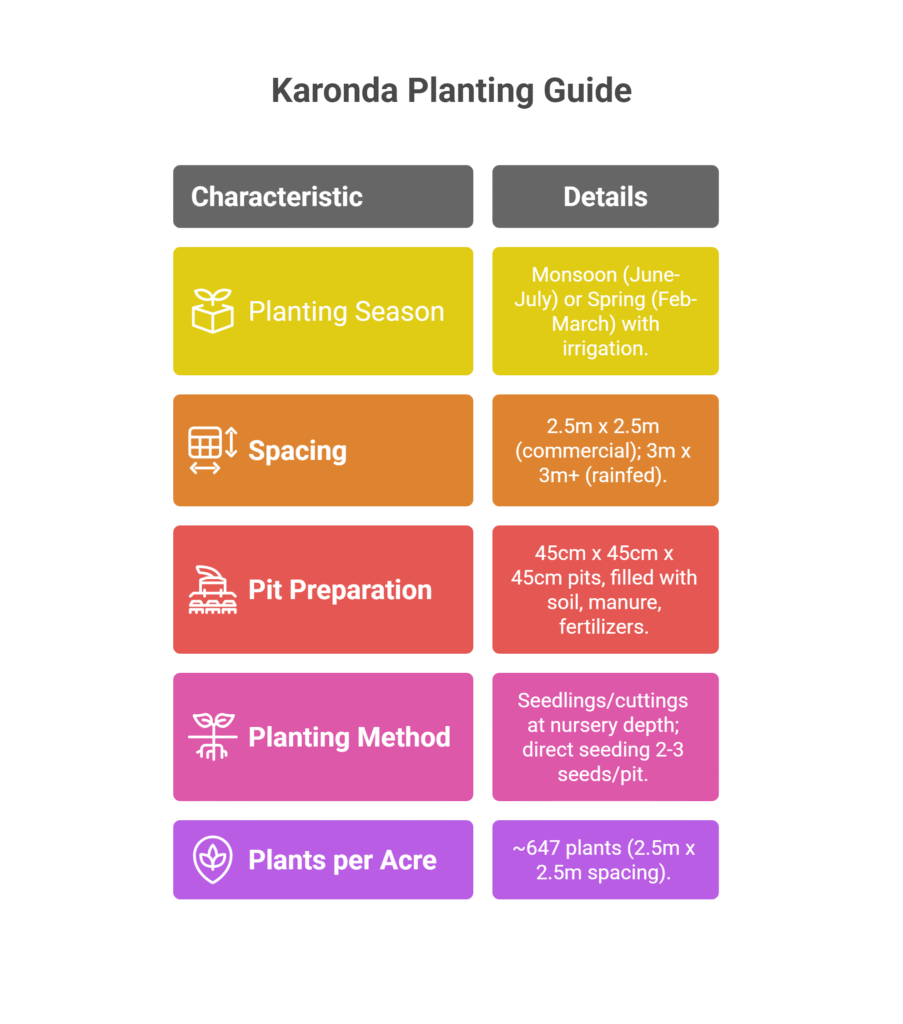
Spacing
In commercial Karonda orchards, a spacing of 2.5 meters by 2.5 meters (about 650 plants per acre) is recommended to promote better canopy development and allow for intercropping, while in rainfed or marginal lands, wider spacing of 3 meters by 3 meters or more is preferred to minimize competition for limited water resources.
Pit Preparation
About two to four weeks prior to planting, pits for Karonda planting should be excavated at the designated areas, measuring 45 cm x 45 cm x 45 cm.
In addition to 100 g of Single Super Phosphate (SSP), 50 g of Muriate of Potash (MOP), 50 g of Trichoderma viride to inhibit fungal germs, and 50 g of neem cake to repel insects, the pits are filled with a mixture of topsoil and 15–20 kg of well-rotted Farmyard Manure (FYM) or compost. After that, the pit is filled again and raised just a little bit above the ground to give it time to settle. If at all feasible, watering is done before planting.
Planting Method
For planting Karonda, seedlings should be carefully removed from polybags or root trainers and placed in the center of the prepared pit at the same depth they were growing in the nursery, followed by gently filling and firming the soil and watering thoroughly. Hardened cuttings or separated layers are planted in the same manner as seedlings. For direct seeding, sow 2–3 seeds per pit at a depth of 2–3 cm and thin out to retain the strongest seedling once they emerge.
Number of Plants per Acre
Based on the spacing of 2.5m x 2.5m, approximately 647 plants per acre are planted, which is the common density used in Karonda orchards.
Intercropping
Intercropping is highly recommended in Karonda orchards, especially during the first 3–4 years before the canopy closes, as it provides additional income and makes efficient use of available space. Suitable intercrops include low-growing, non-climbing, shallow-rooted, and short-duration crops that do not compete significantly for light, water, or nutrients.
These include vegetables such as beans, cowpea, peas, onion, garlic, leafy greens, radish, and carrot; pulses like green gram (moong) and black gram (urad); medicinal and aromatic plants such as basil (Tulsi) and mint, which requires moisture; and flowers like marigold, which also help deter pests.
However, tall crops like maize and sugarcane, climbing vines such as pumpkin and cucumber (unless properly trained), and deep-rooted or long-duration crops that compete directly with Karonda should be avoided.
Irrigation
| Growth Phase | Irrigation Requirements | Critical Notes |
| Establishment Phase (First Year) | Critical. Water immediately after planting. Frequency: Every 3-4 days during dry spells for the first few months. | Gradually reduce frequency as roots establish. |
| Young Plants (1-3 years) | Frequency: Every 7-10 days during summer/dry periods. Less frequent in winter. | Ensure consistent moisture, especially in heat. |
| Mature Plants (4+ years) | Generally: Not essential in moderate rainfall areas (highly drought-tolerant). Strategic Boost: 2-3 irrigations significantly improve yield & quality: 1. Pre-flowering: (Feb-Mar) 2. Fruit setting: (Apr-May) 3. Fruit development: (May-Jun) | Fruit development stage is MOST critical. Essential for optimal fruit size and quality. |
| Method | Common: Basin irrigation. Recommended: Drip irrigation (highly efficient, conserves water, reduces weeds). | Drip systems optimize water use and target root zones. |
| Waterlogging | ABSOLUTELY AVOID. | Ensure perfect drainage. Waterlogged conditions cause root rot and plant death. |
Fertilizer and Manure
| Category | Details | Timing & Method | Notes |
| Organic Manure | Type: Well-rotted FYM/Compost Rate: 15-20 kg per plant per year | Timing: Onset of monsoon or late winter. Method: Apply around the drip line. Incorporate lightly. | Foundation for soil health. Koronda responds very well to organic inputs. |
| Inorganic Fertilizers (Per Plant Per Year) | |||
| Year 1: 100g N, 50g P₂O₅, 50g K₂O | Apply full dose pre-flowering. | ||
| Year 2: 200g N, 100g P₂O₅, 100g K₂O | Apply full dose pre-flowering. | ||
| Year 3: 300g N, 150g P₂O₅, 150g K₂O | Apply full dose pre-flowering. | ||
| Mature Plants (Year 4+): 500g N, 250g P₂O₅, 250g K₂O | N: Split – Half pre-flowering, Half post-fruit set. P & K: Full dose pre-flowering. | Critical for optimal yield and fruit quality in bearing plants. | |
| General Application | Broadcast fertilizers evenly within the drip line. | Incorporate lightly into soil. Follow with irrigation if possible. | Ensures nutrients reach feeder roots. Avoid direct contact with trunk. |
| Micronutrients | Deficiencies (e.g., Zinc, Iron) may occur in highly alkaline soils. | Correct based on soil/leaf analysis: – Foliar sprays (e.g., 0.5% ZnSO₄) – Soil application | Targeted correction only after confirmation of deficiency |
Weed Control
Weed control is critical during the early stages of Karonda growth, as young plants are poor competitors against weeds. Mechanical and cultural methods such as regular hoeing and hand weeding within a 1-meter radius basin and the inter-row spaces are essential.
Applying a 5–10 cm layer of organic mulch—such as paddy straw, dried grass, or black plastic—around the plant base effectively suppresses weeds, conserves soil moisture, and improves soil health.
Chemical control should be used cautiously; a pre-emergence application of Pendimethalin at the recommended dose of 400 – 600g active ingredient per acre on clean, moist soil can help manage germinating weeds, while glyphosate must be applied carefully with plant protection measures to avoid damage.
Post-emergence herbicides are generally avoided near young plants. In mature orchards, weed pressure decreases under canopy shade, but the basin area should still be kept free of weeds.
Interculture Operation (Training and Pruning)
Training
The training of Karonda plants focuses on developing a strong framework by encouraging 3 to 4 well-spaced primary branches while removing low branches below 45 cm and eliminating inward-growing or crossing branches early to ensure healthy growth and proper canopy structure.
Pruning
The goals of pruning Karonda plants are to keep them in shape, improve airflow and light penetration, get rid of diseased or dead wood, manage size, and encourage new fruit-bearing growth. Removing dead, damaged, or broken branches, thinning crowded and inward-growing shoots, tip pruning excessively long shoots to encourage branching, and removing vigorous upright water sprouts and suckers from the base are all gentle ways to accomplish this with sharp, sanitized secateurs. Plant height should also be controlled to make harvesting easier.
Flowering and Fruit Management
Karonda flowers in spring (March–April), producing small, fragrant, white to pinkish star-shaped flowers in terminal clusters that bloom for 2–3 weeks. While cross-pollination by insects enhances fruit set, it is not absolutely necessary. After pollination, fruits develop quickly, maturing from green to ripe over 90–100 days.
A minor natural fruit drop, known as the “June drop,” is common, but severe fruit loss may occur due to water stress, nutrient imbalances—particularly boron deficiency—or pest and disease attacks. Adequate irrigation and balanced nutrition during fruit development are essential to minimize fruit drop. Unlike many major fruit crops, commercial thinning is generally not practiced in Karonda cultivation.
Pest and Disease Management
Common Pests
Fruit Fly
Fruit fly is a major pest of Karonda, with larvae feeding inside ripening fruits, causing significant damage. Effective management includes bait sprays combining Malathion at 2 ml per liter with protein hydrolysate to attract and kill adults. Additionally, pheromone traps can be deployed to monitor and reduce adult populations. Maintaining field sanitation by regularly collecting and destroying fallen infested fruits helps break the pest cycle. Early harvesting fruits before peak infestation also reduces losses.
Mealybugs
Mealybugs feed by sucking sap from the plant and excrete honeydew, which encourages sooty mold growth. Management involves spraying strong jets of water to dislodge the insects, releasing natural predators like Cryptolaemus ladybird beetles, and applying neem oil at 2% concentration or insecticidal soap. In severe infestations, a chemical spray of dimethoate at 1.5 ml per liter can be used, following safety guidelines.
Scale Insects
Both armored and soft scales attack stems and leaves, weakening the plant. Control measures include dormant oil sprays during the off-season to smother overwintering scales, regular applications of neem oil at 2%, and chemical insecticides such as malathion or dimethoate at recommended doses of 2 ml per liter. Proper timing and thorough coverage are critical for effectiveness.
Aphids
Aphids typically cluster on new shoots, feed on sap and potentially transmitting diseases. Management includes using strong water sprays to remove aphids physically, applying neem oil at 2%, or spraying imidacloprid at 0.3 ml per liter for more severe infestations, ensuring to follow label instructions for safe use.
Stem Borer
Larvae of stem borers tunnel into the stems, weakening and sometimes killing branches. Control involves pruning and destroying infested branches to reduce larval populations. Injecting kerosene or dichlorvos into stem holes can kill larvae inside. Painting the trunk with carbaryl at 2 grams per liter provides a protective barrier against adult borers. Always take safety precautions when handling these chemicals.
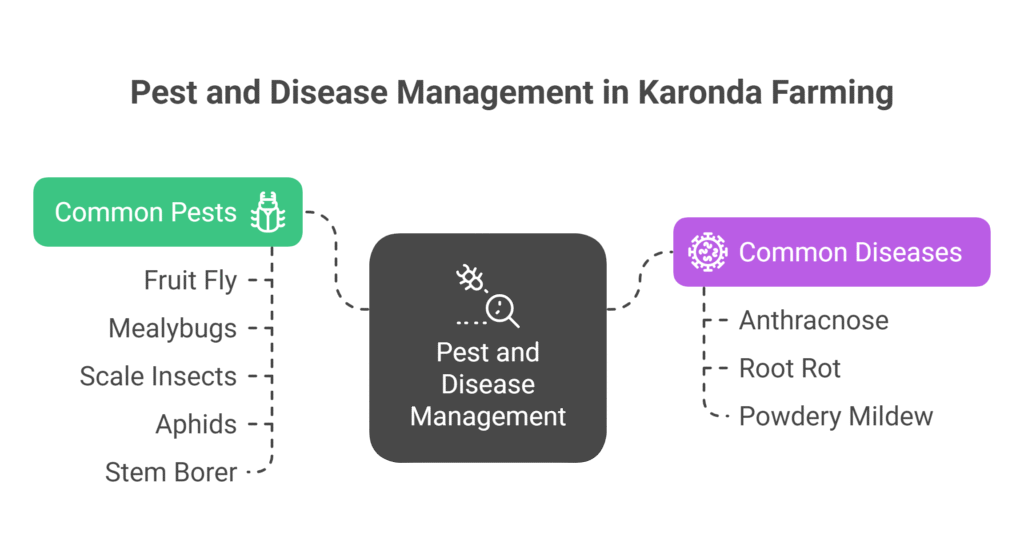
Common Diseases
Anthracnose
Fruit rot and defoliation result from the fungal disease anthracnose, which creates dark, sunken patches on fruits and foliage. Regular sprays of copper oxychloride (3 grams per liter) or Mancozeb (2–2.5 grams per liter) are advised to treat anthracnose. These treatments should begin at the beginning of symptoms and continue at 10- to 15-day intervals. Debris from sick plants should be removed and destroyed as part of good field sanitation to lessen the pressure of illness.
Root Rot
Root Rot In wet soils, fungus like Phytophthora create root rot, which causes wilting and plant death. In order to prevent waterlogging, management focuses on enhancing soil drainage and minimizing overwatering.
Controlling the pathogen can be achieved by fungicidal drenching with biological agents such as Trichoderma (5 grams per liter) or chemical fungicides like Bordeaux mixture (a copper sulfate and lime mixture) at 1% concentration or carbendazim (2 grams per liter). Careful application is necessary to reach the root zone.
Powdery Mildew
A white, powdery fungal growth on leaves and young shoots is known as powdery mildew, and it can lower photosynthesis and plant vigor in general. Spraying wettable sulfur at 2 grams per liter, Dinocap at the prescribed dosages, or carbendazim at 2 grams per liter are examples of control measures. For efficient treatment, these fungicides should be used as soon as an infection appears and then again, every 10 to 14 days as necessary.
Harvesting
Maturity Indices
Karonda fruits change color as they mature, transitioning from green to pinkish-red, red, or deep purple/black depending on the cultivar. They develop a slight softness and acquire a characteristic sour or sweet-sour taste. For processing purposes such as making pickles or preserves, slightly under-ripe fruits that are light pink or red but fully sized are often preferred due to their firmness and higher acidity.
Time
The main harvesting season for Karonda is from June to August, with the peak period occurring in July. Harvesting can continue for 4 to 6 weeks depending on fruit development and cultivar.
Method
Harvesting is done manually by hand, with workers wearing gloves to protect against the plant’s thorns. Since the fruits are delicate, they must be handled carefully to prevent bruising. Harvesting is best done during the cool morning hours, and clippers may be used to reach fruits that are difficult to pick by hand. Selective picking is necessary because the fruits often ripen unevenly.
Frequency
During the peak harvesting season, fruits should be harvested every 3 to 4 days to ensure picking at the right stage of ripeness and to maintain fruit quality.
Yield
| Factor | Yield Details |
| Young Plants (3-4 years) | 1–2 kg per plant per year |
| Mature Plants (5-7 years onwards) | Average: 6-8 kg per plant per year |
Cost of Investment Per Acre for Karonda Farming
| S.N. | Categories | Cost for Investment (NRs.) |
| 1 | Land Preparation (plowing) | 15,000 |
| 2 | Plant Saplings | 130,000 |
| 3 | Pit Digging | 8,000 |
| 4 | Planting | 7,000 |
| 5 | Fertilizers and Manure | 65,000 |
| 6 | Irrigation | 25,000 |
| 7 | Weed Control (pre & post-emergence) | 7,000 |
| 8 | Pest & Disease Control | 10,000 |
| 9 | Miscellaneous Costs | 10,000 |
| Total Cost | 277,000 |
Annual Maintenance Cost Per Acre for Karonda Farming
From the second year onward, the annual maintenance cost for Karonda farming is approximately NRs. 75,000 per acre, covering essential activities such as irrigation, fertilization, pest and disease control, weed management, and other routine care necessary to sustain healthy plant growth and optimize fruit production. This ongoing expense is crucial to ensure the longevity and productivity of the orchard, supporting the maintenance of soil fertility, plant health, and overall farm management practices.
Income per acre from Karonda Farming
| Year | Estimated Yield per Tree (kg) | Estimated Yield per Acre (kg) | Market Price (NRs/kg) | Total Income per Acre (NRs) |
| 3rd Year | 1 | 647 | 100 | 64,700 |
| 4th Year | 2 | 1,294 | 100 | 129,400 |
| 5th Year | 3 | 1,941 | 100 | 194,100 |
| 6th Year | 4 | 2,588 | 100 | 258,800 |
| 7th Year | 5 | 3,235 | 100 | 323,500 |
| 8th-15th Year | 6 | 3,882 | 120 | 388,200 |
| 16th Year | 5 | 3,235 | 120 | 323,500 |
| 17th Year | 4.5 | 2,911.5 | 130 | 291,150 |
| 18th-20th Year | 3.5 | 2,264.5 | 130 | 226,450 |
Analysis of Karonda Farming Profit Per Acre
| Year | Income (NRs) | Costs (NRs) | Net Profit (NRs) |
| 1st Year | 0 | 277,000 (Initial investment) | -277,000 |
| 2nd Year | 0 | 75,000 (maintenance) | -75,000 |
| 3rd Year | 64,700 | 75,000 | -10,300 |
| 4th Year | 129,400 | 75,000 | 54,400 |
| 5th Year | 194,100 | 75,000 | 119,100 |
| 6th Year | 258,800 | 75,000 | 183,800 |
| 7th Year | 323,500 | 75,000 | 248,500 |
| 8th-15th Year | 388,200 | 75,000 | 313,200 |
| 16th Year | 323,500 | 75,000 | 248,500 |
| 17th Year | 291,150 | 75,000 | 216,150 |
| 18th-20th Year | 226,450 | 75,000 | 151,450 |
Over a 20-year period, the total costs for karonda farming amount to NRs. 1,702,000, comprising an initial investment of NRs. 277,000 and maintenance costs of NRs. 1,425,000 (calculated as 19 years × NRs. 75,000/year from Year 2 onwards). Total income generated from Years 3–20 is NRs. 5,370,250, with NRs. 970,500 in Years 3–7, NRs. 3,105,600 during the peak Years 8–15, and NRs. 1,294,150 in Years 16–20.
This results in a net profit of NRs. 3,668,250 (Total Income – Total Costs). Key insights reveal the break-even point is achieved in Year 7, when cumulative profit turns positive. The peak profit phase (Years 8–15) delivers consistent annual earnings of NRs. 313,200, while the decline phase (Years 16–20) maintains profitability despite lower yields, due to higher market prices (NRs. 120–130/kg).
Sources
Food and Agriculture Organization (FAO)
University of California Agriculture & Natural Resources (UC ANR)
European Plant Protection Organization (EPPO)
Punjab Agricultural University (PAU)
Tamil Nadu Agriculture University (TNAU) – Agritech portal
Indian Council of Agricultural Research (ICAR)
Nepal Agricultural Research Council (NARC)
U.S. Department of Agriculture (USDA).
Jadhav, S. D., Nangare, D. D., & Kakade, V. S. (2022). Karonda: Under-exploited fruit crop for dry land condition. ICAR–NIASM, Baramati, Pune.
Disclaimer: This crop farming profits assume optimal conditions. Actual results may vary depending on climate, market prices, and farm management practices.

